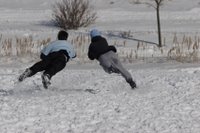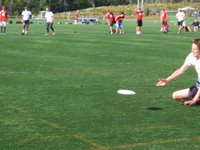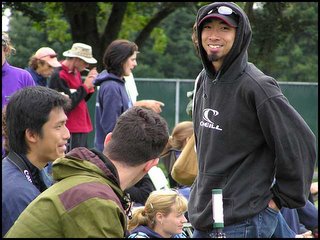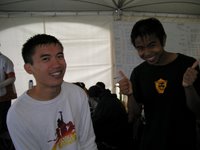Hey Folks,
I extracted a little article I wrote in the past as a How-to guide for Touring players. I thought I would post it hear. A pdf file can be found here.
Tournament Protocol by Peter Jamieson, Edited by Jack Cooney
So you like Ultimate, and you're not satisfied with the day-to-day league play. You have decided to try touring. What is touring? What is touring like? Finally, how to I get involved, and what do I do? This document attempts to answer these questions with particular emphasis on how to behave at tournaments.
What is touring?
Touring is essentially going to tournament on a weekend and playing against other teams from other cities. These teams are in general better than your average league team mainly because these people play and practice Ultimate lots.
Does this mean that you need to be exceptional to play Ultimate at the touring level? That's a tough question. Many touring players are definitely medium grade athletes who have found a game that they like to play competitively. On the other hand, there are many teams that just play for the enjoyment of Ultimate and hanging out with friends on the weekend. The progression of Ultimate seems to be, like all sports, a flow from pure fun and competition to more of a competitive sport. I don't necessarily think this is the best progression of the sport, but it is the reality.
In general, a player who would like to tour needs to be good enough shape or willing to get in shape to play 7 games of ultimate over two days. Tournaments typically involve 3-5 games of pool play on the first day, and 2-3 games on the Sunday. These games last approximately 1.5 hours or go up to 13 or 15. In reality this is a lot of running and is extremely hard on the body, but touring players are a different breed, and seem to thrive off playing lots.
In addition to pure playing, there is the fun element to ultimate. Essentially, after a day of hard play it is traditional to head out to a party to dance out those aches and pains. In addition to the organized party, there is the enjoyment of hanging out with friends, enjoying the company of others in a different city. The main thing is you get to hang out with a group of people for a weekend and you really bond with a team.
How to I get involved?
There are many ways to get involved in touring. The first thing you have to decide is what is your goal in Ultimate. If you just want to tour for the sake of the party, it is probably easier to follow the tournaments as a photographer or tournament volunteer. If you want to play for fun, then you need to find a casual team, usually a co-ed league team that goes to a few tournaments a year. If you’re looking for competitive ultimate, you should try-out and talk to competitive teams. There are competitive teams at all levels for men, women, and couples. Also, there are many different levels of competition.
In reality, for a competitive team you need to tryout for the team. Tryout, in the Ultimate world, can mean a lot of things. First, teams are usually looking for players who are competent in basic skills. This means that you know basic throws, offence, and defense. There are teams that exist to train individuals, but don’t expect a team like this to instantly take you to a tournament. In systems like these, an individual is expected to practice until a point when they are ready to be taken to a tournament. A tryout also is an opportunity for a team to determine if you are the type of person that fits in with the team. This is particularly important since Ultimate players pay to tour, and nobody wants to spend a tournament with someone they don't like. It is easy to find out the attitudes of the team you will be playing with, and it is also easy to determine if your personality will fit with the team (see below for details on how not to alienate your team).
If you are a student, there are also opportunities to join Ultimate touring at the high school and University level. These teams will develop your skills, but since ultimate is becoming more and more popular touring positions are becoming more and more competitive.
Keep in mind that Ultimate was created for people to have fun. Touring is an extension of this concept. Regardless of the competitive movement that is coming up in Ultimate, expect that people will create tournaments of various levels so we can all go and enjoy the sport. Talk to people in your respective club. They'll tell you what teams are like and what style of team may suit your needs.
What do I do?
This is the section that I would like to use to describe basic etiquette for touring. Essentially, there are two things that are important when touring - please your team and please your tournament.
Pleasing the tournament is simple. Play hard, but play nice. The reality is that players are not paid to be there; they are paying for the privilege of playing. Therefore, nobody wants to play with a bastard. That’s what hockey, basketball, and football are for. At a tournament, it is understandable that some people will get hot headed and over react during some certain plays, but in general spirited play makes a weekend much more enjoyable. Also, as tournaments become high demand events, competitive spirited teams will hopefully get the bids.
Pleasing the team involves a series of things. Practice hard and play hard. Listen to the leader. Pay your fees on time. Find a way to get to the tournament and find a place to stay. I'll go over these points in more detail.
- Practice hard - practice is your once or twice a week meeting time with the team. The nice thing about practice is that it is normally higher quality Ultimate than you will get during regular league play as long as you don't slack off. Come to practice and work hard, but more importantly use the time to listen and learn. Practice is tournament simulation so that you're prepared for tournament situations. You can play around on your own time, but practice is a focused group event that attempts to satisfy team goals. Finally, practice is not the place to contradict team plans -- it's usually better to take up issues privately with your captain.
- Listen to the Leader - Once again, Ultimate is an amateur sport. We have captains, coaches, and online captains. These people are not trained, and they're just out to have fun like you. To make it easy for them, listen to what they have to say, and don’t contradict them at a tournament or practice. Talk to the person in private, in between games, or before/after practice. Otherwise, listen, do-it, and think about it. It makes their lives easier (and yours as well).
- Don't ask for permission to go to pee - just because someone runs the team doesn't mean they make every decision in the world. They're not in charge of everything so take it upon yourself to help make trivial decisions. Help out in figuring out where the team is going to stay. Help in figuring out how to get to the tournament. Basically, don't expect the leader to deal with every little situation.
- Get yourself to the tournament - this mainly applies to younger teams, but if you don't have a car find out who does, or rent a car with a group of people. If you decide to rent with a group then rent, and don't back out if you find a free ride by chance. If you ride with somebody, pay for gas. Respect your driver's car. Make sure somebody is awake when the driver is riding home from the tournament [shotguns job]. Basically, someone with a car is doing you a huge favour so you should go out of your way to accommodate him or her.
- Find a place to stay - my first recommendation is stay with the team. You'll have more fun if you're with the team and you'll save a lot of pain for drivers going all around town to pick up strays. Many teams get a few hotel rooms and fill them up depending on finances. For young teams the guys and gals with jobs usually get the beds and pay a little more so the people on the floor can pay a little less. If you stay with the team it, you’ll go to the party, you'll hang out, and in general you'll have more fun because you're bonding with the team.
- Pay for it now - Since we pay for tournaments, somebody has to put up +200$ for fees as well as hotel rooms. Pay them as quickly as possible to even things out as quickly as possible.
- Build a phone network - If you have a cell phone, or you know the number you're staying at, e-mail the phone number to the team ahead of time. If you are technologically advanced, build some list ahead of time. This solves a lot of problems once you are in a strange city.
- Remember the basics - Tournaments are held out in the sun so bring your sunscreen! But really, you should be prepared for any kind of weather. Don’t forget warm clothes, cool clothes, rain gear, a hat, water, socks, underwear, soap, wallet, a disc, or in other words the basics.
- Drink responsibly - (note to the author!) It is fun to party, but remember that you have to play the next day. Therefore, the best plan for the party is clean up fast, get to
the party, drink with responsibility and a designated driver, and get home at an hour so you can get some rest for the next day. Each person knows their limit so make sure you don’t overdo it. Make sure you have a buddy to make sure you are both okay.
- Play hard - game play is also important. This is what you have practiced for, so you might as well play as hard as you can. Tournaments are meant to be fun, but if you aren't giving your best effort your wasting your time and letting down the team. Be positive, have fun, and enjoy the weekend. This is what it is all about.
PJ
 Pictured Above: Kirk Nylen laying out in the snow at Snowplate 2006 up in Sudbury, ON (taken from Arthur Tateishi Photography).
Pictured Above: Kirk Nylen laying out in the snow at Snowplate 2006 up in Sudbury, ON (taken from Arthur Tateishi Photography).











